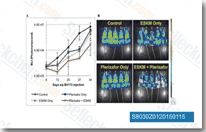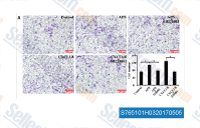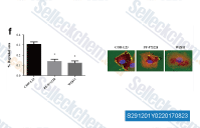
- Bioactive Compounds
- By Signaling Pathways
- PI3K/Akt/mTOR
- Epigenetics
- Methylation
- Immunology & Inflammation
- Protein Tyrosine Kinase
- Angiogenesis
- Apoptosis
- Autophagy
- ER stress & UPR
- JAK/STAT
- MAPK
- Cytoskeletal Signaling
- Cell Cycle
- TGF-beta/Smad
- Compound Libraries
- Popular Compound Libraries
- Customize Library
- Clinical and FDA-approved Related
- Bioactive Compound Libraries
- Inhibitor Related
- Natural Product Related
- Metabolism Related
- Cell Death Related
- By Signaling Pathway
- By Disease
- Anti-infection and Antiviral Related
- Neuronal and Immunology Related
- Fragment and Covalent Related
- FDA-approved Drug Library
- FDA-approved & Passed Phase I Drug Library
- Preclinical/Clinical Compound Library
- Bioactive Compound Library-I
- Bioactive Compound Library-Ⅱ
- Kinase Inhibitor Library
- Express-Pick Library
- Natural Product Library
- Human Endogenous Metabolite Compound Library
- Alkaloid Compound LibraryNew
- Angiogenesis Related compound Library
- Anti-Aging Compound Library
- Anti-alzheimer Disease Compound Library
- Antibiotics compound Library
- Anti-cancer Compound Library
- Anti-cancer Compound Library-Ⅱ
- Anti-cancer Metabolism Compound Library
- Anti-Cardiovascular Disease Compound Library
- Anti-diabetic Compound Library
- Anti-infection Compound Library
- Antioxidant Compound Library
- Anti-parasitic Compound Library
- Antiviral Compound Library
- Apoptosis Compound Library
- Autophagy Compound Library
- Calcium Channel Blocker LibraryNew
- Cambridge Cancer Compound Library
- Carbohydrate Metabolism Compound LibraryNew
- Cell Cycle compound library
- CNS-Penetrant Compound Library
- Covalent Inhibitor Library
- Cytokine Inhibitor LibraryNew
- Cytoskeletal Signaling Pathway Compound Library
- DNA Damage/DNA Repair compound Library
- Drug-like Compound Library
- Endoplasmic Reticulum Stress Compound Library
- Epigenetics Compound Library
- Exosome Secretion Related Compound LibraryNew
- FDA-approved Anticancer Drug LibraryNew
- Ferroptosis Compound Library
- Flavonoid Compound Library
- Fragment Library
- Glutamine Metabolism Compound Library
- Glycolysis Compound Library
- GPCR Compound Library
- Gut Microbial Metabolite Library
- HIF-1 Signaling Pathway Compound Library
- Highly Selective Inhibitor Library
- Histone modification compound library
- HTS Library for Drug Discovery
- Human Hormone Related Compound LibraryNew
- Human Transcription Factor Compound LibraryNew
- Immunology/Inflammation Compound Library
- Inhibitor Library
- Ion Channel Ligand Library
- JAK/STAT compound library
- Lipid Metabolism Compound LibraryNew
- Macrocyclic Compound Library
- MAPK Inhibitor Library
- Medicine Food Homology Compound Library
- Metabolism Compound Library
- Methylation Compound Library
- Mouse Metabolite Compound LibraryNew
- Natural Organic Compound Library
- Neuronal Signaling Compound Library
- NF-κB Signaling Compound Library
- Nucleoside Analogue Library
- Obesity Compound Library
- Oxidative Stress Compound LibraryNew
- Plant Extract Library
- Phenotypic Screening Library
- PI3K/Akt Inhibitor Library
- Protease Inhibitor Library
- Protein-protein Interaction Inhibitor Library
- Pyroptosis Compound Library
- Small Molecule Immuno-Oncology Compound Library
- Mitochondria-Targeted Compound LibraryNew
- Stem Cell Differentiation Compound LibraryNew
- Stem Cell Signaling Compound Library
- Natural Phenol Compound LibraryNew
- Natural Terpenoid Compound LibraryNew
- TGF-beta/Smad compound library
- Traditional Chinese Medicine Library
- Tyrosine Kinase Inhibitor Library
- Ubiquitination Compound Library
-
Cherry Picking
You can personalize your library with chemicals from within Selleck's inventory. Build the right library for your research endeavors by choosing from compounds in all of our available libraries.
Please contact us at [email protected] to customize your library.
You could select:
- Antibodies
- Bioreagents
- qPCR
- 2x SYBR Green qPCR Master Mix
- 2x SYBR Green qPCR Master Mix(Low ROX)
- 2x SYBR Green qPCR Master Mix(High ROX)
- Protein Assay
- Protein A/G Magnetic Beads for IP
- Anti-Flag magnetic beads
- Anti-Flag Affinity Gel
- Anti-Myc magnetic beads
- Anti-HA magnetic beads
- Poly FLAG Peptide lyophilized powder
- Protease Inhibitor Cocktail
- Protease Inhibitor Cocktail (EDTA-Free, 100X in DMSO)
- Phosphatase Inhibitor Cocktail (2 Tubes, 100X)
- Cell Biology
- Cell Counting Kit-8 (CCK-8)
- Animal Experiment
- Mouse Direct PCR Kit (For Genotyping)
- New Products
- Contact Us
CXCR
CXCR Products
- All (24)
- CXCR Inhibitors (3)
- CXCR Antagonists (19)
- CXCR Agonist (1)
- CXCR Modulator (1)
- New CXCR Products
| Catalog No. | Product Name | Information | Product Use Citations | Product Validations |
|---|---|---|---|---|
| S8030 | Plerixafor (AMD3100) | Plerixafor (AMD3100, JM 3100, SID791) is a chemokine receptor antagonist for CXCR4 and CXCL12-mediated chemotaxis with IC50 of 44 nM and 5.7 nM in cell-free assays, respectively. Plerixafor inhibits human immunodeficiency virus (HIV) replication. |

|
|
| S7651 | SB225002 | SB225002 is a potent, and selective CXCR2 antagonist with IC50 of 22 nM for inhibiting interleukin IL-8 binding to CXCR2, > 150-fold selectivity over the other 7-TMRs tested. |

|
|
| S3013 | Plerixafor (AMD3100) 8HCl | Plerixafor (AMD3100, JM 3100,Plerixafor Octahydrochloride,AMD3100 octahydrochloride,SID791 octahydrochloride) 8HCl is the hydrochloride of Plerixafor, a chemokine receptor antagonist for CXCR4 and CXCL12-mediated chemotaxis with IC50 of 44 nM and 5.7 nM in cell-free assays, respectively. Plerixafor can be used as an anti-HIV agent. |

|
|
| S2912 | WZ811 | WZ811 is a highly potent competitive CXCR4 antagonist with EC50 of 0.3 nM. |

|
|
| S8640 | Reparixin (Repertaxin) | Reparixin (Repertaxin, DF 1681Y) is a potent and specific inhibitor of CXCR1 with IC50 of 1 nM. Reparixin (Repertaxin) inhibits PMN migration induced by CXCL8 (IC50 = 1 nM) and rodent PMN chemotaxis induced by CXCL1 and CXCL2. Repertaxin inhibits the response of human PMN to CXCL1, which interacts with CXCR2 (IC50 = 400 nM). | ||
| S8813 | LIT-927 | LIT-927 is a novel neutraligand of CXCL12 with Ki value of 267 nM for inhibition of Texas red-labeled CXCL12 (CXCL12-TR) binding. It shows high selectivity toward CXCL12 vs other chemokines also involved in asthma. | ||
| S8506 | Navarixin (SCH-527123) | Navarixin (SCH-527123, MK-7123, PS-291822) is a potent, orally bioavailable CXCR2/CXCR1 antagonist with IC50 values of 2.6 nM and 36 nM, respectively. | ||
| S4785 | Nicotinamide N-oxide | Nicotinamide N-oxide (Nicotinamide 1-oxide, 1-oxynicotinamide) is recognized as an in vivo metabolite of nicotinamide which is a precurser of nicotinamide-adenine dinucleotide (NAD+) in animals. Nicotinamide N-oxide is novel, potent, and selective antagonists of the CXCR2 receptor. | ||
| S8869 | UNBS5162 | UNBS5162 is a pan-antagonist of CXCL chemokine expression with in vitro cytotoxic activity (IC50 range of 0.5-5 µM) against a range of human cancer cell lines including glioblastoma (Hs683 and U373MG), colorectal (HCT-15 and LoVo), non-small-cell lung (A549) and breast (MCF-7). | ||
| S8505 | LY2510924 | LY2510924 is a potent and selective CXCR4 antagonist that specifically blocks SDF-1 binding to CXCR4 with IC50 value of 0.079 nmol/L and inhibits SDF-1-induced GTP binding with Kb value of 0.38 nmol/L. | ||
| S6645 | AZD5069 | AZD5069 is a novel antagonist of CXCR2, which is shown to inhibit binding of CXCL8 to CXCR2 with a pIC50 value of 8.8 and inhibit CXCL8 binding to CXCR1 with pIC50 values of 6.5. | ||
| S2879 | AMD3465 hexahydrobromide | AMD3465 is a monomacrocyclic CXCR4 antagonist. | ||
| S8682 | AMG 487 | AMG 487 is an orally active and selective CXC chemokine receptor 3 (CXCR3) antagonist that inhibits the binding of IP-10 (CXCL10) and ITAC (CXCL11) to CXCR3 with IC50 of 8.0 nM and 8.2 nM, respectively. | ||
| S8947 | SX-682 | SX-682 is an orally bioavailable small-molecule allosteric inhibitor of CXCR1 and CXCR2 that blocks tumor MDSC recruitment and enhances T cell activation and antitumor immunity. | ||
| S6620 | Danirixin (GSK1325756) | Danirixin (GSK1325756) is a small molecule, non-peptide, high affinity (IC50 for CXCL8 (IL-8) binding = 12.5 nM), selective, and reversible CXCR2 antagonist. | ||
| S6617 | MSX-122 | MSX-122 (Q-122) is a novel small molecule and partial CXCR4 antagonist (IC50~10 nM). | ||
| E1318New | Mavorixafor | Mavorixafor (AMD-070) is a potent, selective CXCR4 antagonist, with an IC50 value of 13 nM against CXCR4 125I-SDF binding. | ||
| S0292 | MSX-127 | MSX-127 (NSC-23026) is a C-X-C chemokine receptor type 4 (CXCR4) receptor antagonist. | ||
| S0293 | MSX-130 | MSX-130 is an antagonist of C-X-C chemokine receptor type 4 (CXCR4). | ||
| S3951 | Tannic acid | Tannic acid (Gallotannic acid), a polyphenolic compound, is a CXCL12/CXCR4 inhibitor with antiangiogenic, anti-inflammatory and antitumor activity. | ||
| S9665 | Motixafortide (BL-8040) | Motixafortide (BL-8040, BKT140, TF 14016, 4-fluorobenzoyl, 4F-benzoyl-TN14003, T140) is an antagonist of CXCR4 with IC50 of ~1 nM. BL-8040 induces the apoptosis of AML blasts by down-regulating ERK, BCL-2, MCL-1 and cyclin-D1 via altered miR-15a/16-1 expression. | ||
| S9516 | SB 265610 | SB265610, a competitive antagonist at the human CXCR2 receptor, can displace [125I]-IL-8 and [125I]-GROα with pIC50 values of 8.41 and 8.47 respectively, preventing receptor activation by binding to a region distinct from the agonist binding site. | ||
| S9725 | Balixafortide (POL6326) | Balixafortide (POL6326) is an orally bioavailable peptidic CXC chemokine receptor 4 (CXCR4) antagonist. |
||
| S8309 | ATI-2341 | ATI-2341, pepducin targeting the C-X-C chemokine receptor type 4 (CXCR4), is an allosteric agonist activating the inhibitory heterotrimeric G protein (Gi) to promote inhibition of cAMP production and induce calcium mobilization. | ||
| S8640 | Reparixin (Repertaxin) | Reparixin (Repertaxin, DF 1681Y) is a potent and specific inhibitor of CXCR1 with IC50 of 1 nM. Reparixin (Repertaxin) inhibits PMN migration induced by CXCL8 (IC50 = 1 nM) and rodent PMN chemotaxis induced by CXCL1 and CXCL2. Repertaxin inhibits the response of human PMN to CXCL1, which interacts with CXCR2 (IC50 = 400 nM). | ||
| S8947 | SX-682 | SX-682 is an orally bioavailable small-molecule allosteric inhibitor of CXCR1 and CXCR2 that blocks tumor MDSC recruitment and enhances T cell activation and antitumor immunity. | ||
| S3951 | Tannic acid | Tannic acid (Gallotannic acid), a polyphenolic compound, is a CXCL12/CXCR4 inhibitor with antiangiogenic, anti-inflammatory and antitumor activity. | ||
| S8030 | Plerixafor (AMD3100) | Plerixafor (AMD3100, JM 3100, SID791) is a chemokine receptor antagonist for CXCR4 and CXCL12-mediated chemotaxis with IC50 of 44 nM and 5.7 nM in cell-free assays, respectively. Plerixafor inhibits human immunodeficiency virus (HIV) replication. |

|
|
| S7651 | SB225002 | SB225002 is a potent, and selective CXCR2 antagonist with IC50 of 22 nM for inhibiting interleukin IL-8 binding to CXCR2, > 150-fold selectivity over the other 7-TMRs tested. |

|
|
| S3013 | Plerixafor (AMD3100) 8HCl | Plerixafor (AMD3100, JM 3100,Plerixafor Octahydrochloride,AMD3100 octahydrochloride,SID791 octahydrochloride) 8HCl is the hydrochloride of Plerixafor, a chemokine receptor antagonist for CXCR4 and CXCL12-mediated chemotaxis with IC50 of 44 nM and 5.7 nM in cell-free assays, respectively. Plerixafor can be used as an anti-HIV agent. |

|
|
| S2912 | WZ811 | WZ811 is a highly potent competitive CXCR4 antagonist with EC50 of 0.3 nM. |

|
|
| S8813 | LIT-927 | LIT-927 is a novel neutraligand of CXCL12 with Ki value of 267 nM for inhibition of Texas red-labeled CXCL12 (CXCL12-TR) binding. It shows high selectivity toward CXCL12 vs other chemokines also involved in asthma. | ||
| S8506 | Navarixin (SCH-527123) | Navarixin (SCH-527123, MK-7123, PS-291822) is a potent, orally bioavailable CXCR2/CXCR1 antagonist with IC50 values of 2.6 nM and 36 nM, respectively. | ||
| S4785 | Nicotinamide N-oxide | Nicotinamide N-oxide (Nicotinamide 1-oxide, 1-oxynicotinamide) is recognized as an in vivo metabolite of nicotinamide which is a precurser of nicotinamide-adenine dinucleotide (NAD+) in animals. Nicotinamide N-oxide is novel, potent, and selective antagonists of the CXCR2 receptor. | ||
| S8505 | LY2510924 | LY2510924 is a potent and selective CXCR4 antagonist that specifically blocks SDF-1 binding to CXCR4 with IC50 value of 0.079 nmol/L and inhibits SDF-1-induced GTP binding with Kb value of 0.38 nmol/L. | ||
| S6645 | AZD5069 | AZD5069 is a novel antagonist of CXCR2, which is shown to inhibit binding of CXCL8 to CXCR2 with a pIC50 value of 8.8 and inhibit CXCL8 binding to CXCR1 with pIC50 values of 6.5. | ||
| S2879 | AMD3465 hexahydrobromide | AMD3465 is a monomacrocyclic CXCR4 antagonist. | ||
| S8682 | AMG 487 | AMG 487 is an orally active and selective CXC chemokine receptor 3 (CXCR3) antagonist that inhibits the binding of IP-10 (CXCL10) and ITAC (CXCL11) to CXCR3 with IC50 of 8.0 nM and 8.2 nM, respectively. | ||
| S6620 | Danirixin (GSK1325756) | Danirixin (GSK1325756) is a small molecule, non-peptide, high affinity (IC50 for CXCL8 (IL-8) binding = 12.5 nM), selective, and reversible CXCR2 antagonist. | ||
| S6617 | MSX-122 | MSX-122 (Q-122) is a novel small molecule and partial CXCR4 antagonist (IC50~10 nM). | ||
| E1318New | Mavorixafor | Mavorixafor (AMD-070) is a potent, selective CXCR4 antagonist, with an IC50 value of 13 nM against CXCR4 125I-SDF binding. | ||
| S0292 | MSX-127 | MSX-127 (NSC-23026) is a C-X-C chemokine receptor type 4 (CXCR4) receptor antagonist. | ||
| S0293 | MSX-130 | MSX-130 is an antagonist of C-X-C chemokine receptor type 4 (CXCR4). | ||
| S9665 | Motixafortide (BL-8040) | Motixafortide (BL-8040, BKT140, TF 14016, 4-fluorobenzoyl, 4F-benzoyl-TN14003, T140) is an antagonist of CXCR4 with IC50 of ~1 nM. BL-8040 induces the apoptosis of AML blasts by down-regulating ERK, BCL-2, MCL-1 and cyclin-D1 via altered miR-15a/16-1 expression. | ||
| S9516 | SB 265610 | SB265610, a competitive antagonist at the human CXCR2 receptor, can displace [125I]-IL-8 and [125I]-GROα with pIC50 values of 8.41 and 8.47 respectively, preventing receptor activation by binding to a region distinct from the agonist binding site. | ||
| S9725 | Balixafortide (POL6326) | Balixafortide (POL6326) is an orally bioavailable peptidic CXC chemokine receptor 4 (CXCR4) antagonist. |
||
| S8309 | ATI-2341 | ATI-2341, pepducin targeting the C-X-C chemokine receptor type 4 (CXCR4), is an allosteric agonist activating the inhibitory heterotrimeric G protein (Gi) to promote inhibition of cAMP production and induce calcium mobilization. | ||
| S8869 | UNBS5162 | UNBS5162 is a pan-antagonist of CXCL chemokine expression with in vitro cytotoxic activity (IC50 range of 0.5-5 µM) against a range of human cancer cell lines including glioblastoma (Hs683 and U373MG), colorectal (HCT-15 and LoVo), non-small-cell lung (A549) and breast (MCF-7). | ||
| E1318New | Mavorixafor | Mavorixafor (AMD-070) is a potent, selective CXCR4 antagonist, with an IC50 value of 13 nM against CXCR4 125I-SDF binding. |
Choose Selective CXCR Inhibitors
Tags: CXCR inhibitor|CXCR agonist|CXCR activator|CXCR inducer|CXCR antagonist|CXCR signaling pathway|CXCR assay kit








































